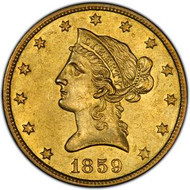Liberty Head Gold Eagles
Posted by Bullion Shark on Jun 15th 2022
Liberty Head Gold Eagles
If you hear someone refer to gold eagles, you might think of the American Gold Eagles issued since 1986. But from the time the first U.S. gold coins were issued in 1795, an eagle or $10 gold coin has been the base unit denomination for American gold coinage. Moreover, until 1933 not only was our gold coinage linked to the $10 eagle coin, but it was also the flagship denomination of our entire system of coinage. And until Double Eagles were launched in 1850, eagles were also widely used for settling international commercial transactions.
When the first eagles were issued from 1795 to 1804, they featured a Liberty design in which the allegorical figure wore a turban, which is why they are known as Turban Head coins. Their gold purity was 22-karat, the same as English crown gold, or 91.667% pure gold with the rest being silver and copper.
In 1834 the ratio between silver and gold wad changed from 15 to 1 to 16 to 1, which resulted in gold purity of these coins being reduced to 89.92% because the higher standard had led to the exporting and melting of many coins. Those that went to Europe only began to return stateside in large numbers after the Berlin Wall came down in 1989.
Then in 1837 a new standard was set for gold coinage of 90% purity, and $10 gold eagles issued since 1838 (because no eagles were made from 1805 to 1837) contain 258 grains, or 16.7 grams of fine gold (0.48375 troy ounces).
Today the U.S. continues to use this standard for its $5 commemorative gold coins, which are based on half eagles, but we have issued a couple modern gold commemoratives that are eagles with a $10 denomination (including the 1984 Los Angeles Olympics, 2000 Library of Congress and 2003 First Flight coins).
Liberty Head Eagles: Three Subtypes
There are two main types of $10 gold eagles that feature a Liberty Head design by Christian Gobrecht, which were issued from 1838 all the way to 1907 – one of the longest runs in U.S. coinage history, especially for gold coinage. Those are the with motto and without motto coins with the motto coins issued from 1866 to 1907, which are also the ones struck in the largest numbers and the ones most typically found today, including in mint state. But at the high end of mint state, they are rare like this coin.
There is a third type, which was actually the first one issued of the three. That is Liberty Head no motto with large letters on the reverse. They all feature Liberty facing left and wearing a coronet or tiara emblazoned with “Liberty” on it and her hair in a bun on their obverse, while the reverse has an eagle with its wings spread with a shield on its breast perched on an olive branch clutching arrows in its talons.
This design was used with slight differences on many other coins such as half cents, large cents and $5 gold coins (quarter and half eagles). As Wayne Homren of the Numismatic Bibliomania Society discussed in 2002 in his E-Sylum publication, it may have been inspired by an 1809 painting of the goddess of love Venus by Benjamin West known as “Omnia Vincit Amor”, which means “Love Triumphs Over Everything”.
The without motto coins were modified in 1839 by changing the truncation line of Liberty’s bust, changing her hair slightly partly so that it no longer covered her hear and making the letters on the reverse smaller. These coins were issued at the Philadelphia Mint from 1838 to 1865 and at the San Francisco Mint from 1854 to 1866 plus at the New Orleans Mint intermittently from 1841 to1906.
As for rarity, the first type (without motto, original portrait and large reverse letters) is very scarce in circulated grades and exceedingly rare in mint state, the second (without motto, small letters on reverse) is relatively common in circulated grades and very scarce in mint state; and the third type with motto is much more common through MS64, according to Ron Guth and Jeff Garrett based on how the market looked in 2005.
Mintages of the second type varied very widely from a low of 1,248 coins in 1863 to a high of 862,258 coins in 1847 (the most common date), while the third type includes some coins with original mintages in the millions and was struck at five mints: the same three as the earlier issues plus Carson City and Denver.
The third type also includes some major rarities such as 1875 (only 100 struck) or 1883-O with 800 made, most of the coins produced at the Carson City Mint and any coins issued before 1880 of this type.
Because of those uber-rare issues and the very long run of this series, it is impossible to collect them all in mint state even on an unlimited budget, and most collectors tend to search for nice examples for their type sets of this design in the highest grade they can afford such as these MS63 coins.
This coin was the final eagle struck at New Orleans and is the scarcest one issued after 1900 and by far the scarcest New Orleans issue of that decade. It is especially rare in high mint state grades and tends to come quite well struck and with better than average eye appeal. And most have a satiny luster, while a small number have a frosty look.
Only 452 of these coins have been graded by PCGS and 505 by NGC in all grades out of an original mintage of 86,895.
Sources:
Dave Bowers, A Guide Book of Gold Eagles (Whitman, 2020)
Ron Guth and Jeff Garrett: United States Coinage: A Study by Type (Whitman, 2005)


